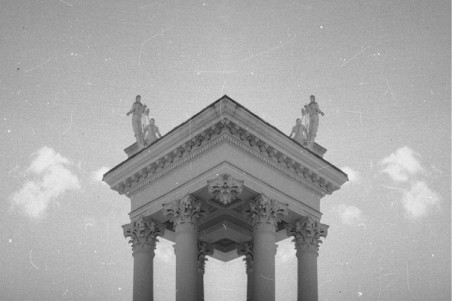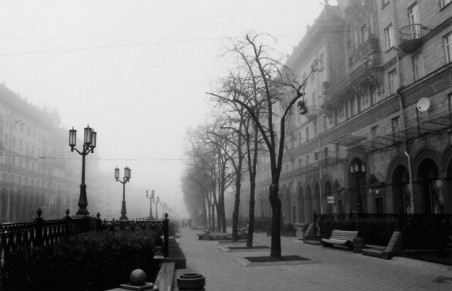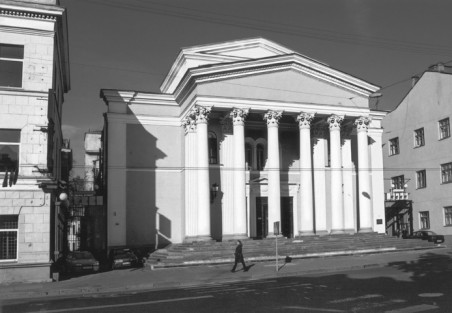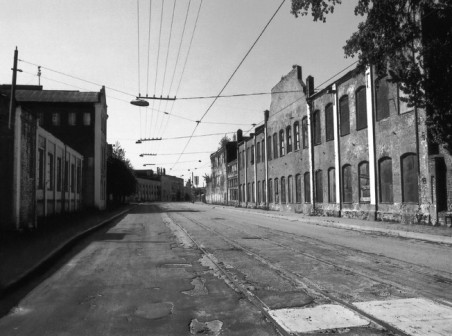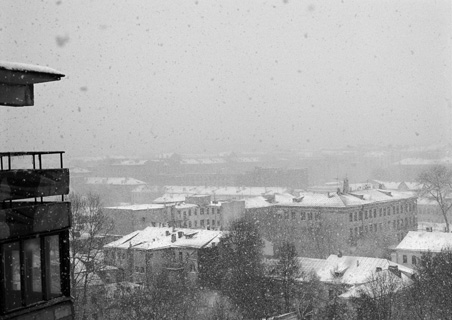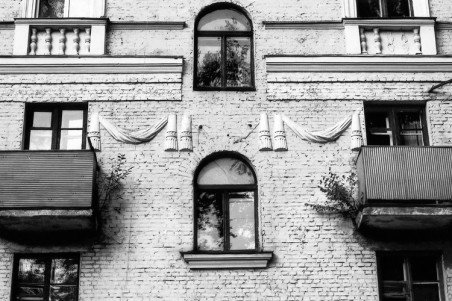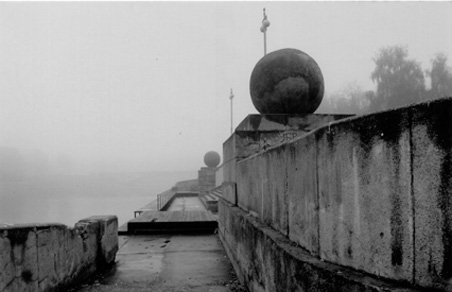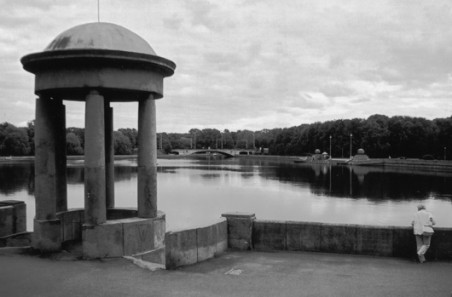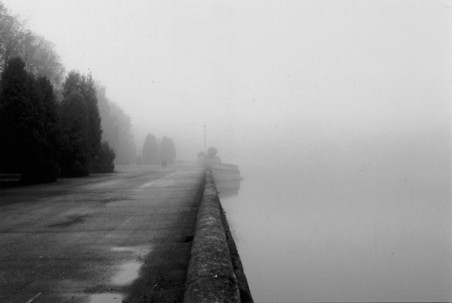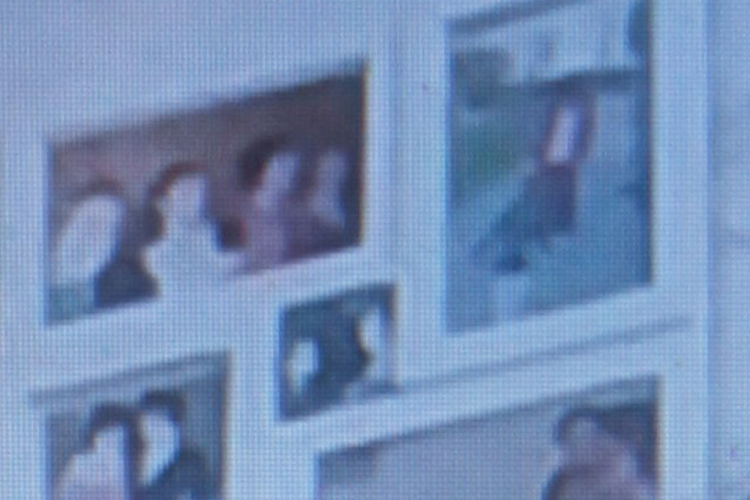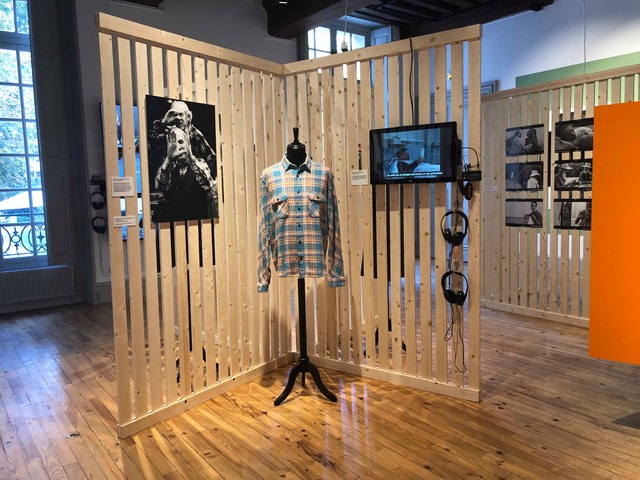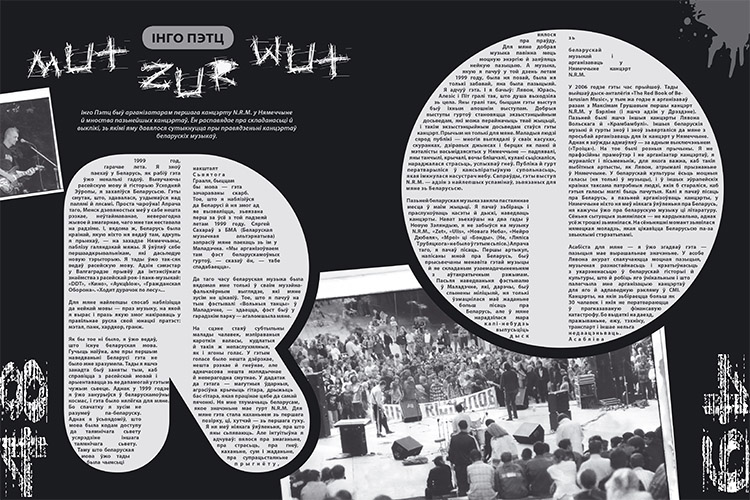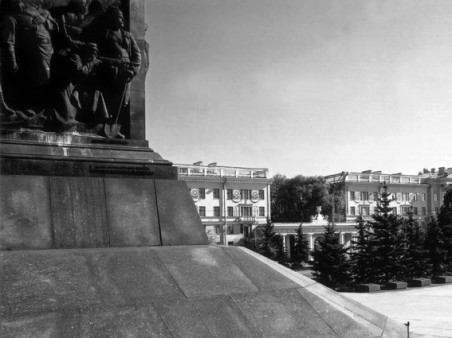
Artur Klinau, The Sun City of Dream Serias
Archive! pARTisan #03’2004
It is going to be a guided tour rather than a philosophical discussion.
To begin with, I would like to explain a bit of Jacques Derrida’s ideas on ghosts, as described in Les Spectres de Marx and why these offer a good perspective on Minsk Architecture. In his book, written in 1993, Derrida reads Marx alongside Hamlet by Shakespeare, centring on the issue of ghosts.
Let us remember Hamlet’s condition. ‘Something is rotten in the state of Denmark/Belarus,’ says Marcellus in Act I. Something must be wrong with a country, if it is haunted by ghosts. Due to ‘his foul and most unnatural murder’ the ghost of the late king, Hamlet’s father is wandering at nighttime. Thinking of our modern ghosts, we should bear in mind that he was murdered with venom poured into his ears. Maybe Shakespeare as well aware of propaganda’s potential for violence. The ghost causes fear. Hamlet is the only one to find understanding with the ghost.
Hamlet’s story is personal and emotional, full of dark things, uncertainties and fear. ‘O my prophetic soul,’ says Hamlet when told the story of his father’s murder. Does the ghost tell nothing but the truth or does he exist as a mere phantom, brought to life by Hamlet’s psychological sufferings? Ghosts are beyond human comprehension. But meeting them is an unforgettable experience. The last words the late king says to Hamlet are ‘remember me’.
Just like Hamlet, Marx felt, too, that ‘the time is out of joint.’ Derrida invites us to re-read the famous initial phrase of The Communist Manifesto: ‘The ghost of communism is wandering in Europe.’ It is the role of ghosts in Marx’s philosophy that Derrida is concerned with. Marx is far from being fascinated by the ghosts. In his opinion, man perceives himself from the perspective of production since it is production that allows man to see himself as a human being of flesh and blood, in other words, free from ghosts. The desire to destroy ghosts is present even in Marx’s philosophy.
***
I wanted to underline in the foreword some ideas that came to my mind inspired by Derrida as I spent two months walking along the streets of Minsk. My vision is that of a stranger, a child, an individual, who is unable to comprehend what he sees and is scared of architectural ghosts, just like Marcellus was. I would like to discuss the functions of architecture and sculpture in creating a communist state’s auto-mythology, as well as their impact and status in Minsk now that it is a decade since the collapse of the USSR and about a decade since Derrida wrote Les Spectres de Marx.
We are still being haunted by ghosts in Minsk. Derrida could have never imagined a ghost as paradoxical as this one.
In Independence Square in front of the House of the Government there is a monument to the late king, who personified the regime, state and ideas, in spite of which Belarus is now strengthening its sovereignty. Reminiscent of Macbeth rather than Hamlet, the man on the pedestal does not take a look at people around, he stares somewhere far away, as if he were eager to go there. It is a representation of power and promise. When the monument was being cast, the time must have already been out of joint. Communist iconography obviously performs a religious function, promising you heavens, only without God. Another monument of history is probably less familiar to you. I mean the WC in my flat as an exemplar of by far less pleasant places, where I did not dare to bring a camera and
where I would always wonder why Soviet WCs were so horrible and whether toilet paper could still be considered a luxury item.
Maybe it was a way of eliminating individuality. But I thought if such a detail as a poor WC reminds you even at the most intimate moments that you are inseparable from the social network, if you keep thinking of Lenin in the loo, it may be a sign that the borderline between the social and private space is being wiped away. We will get back to the subject a bit later on. And now let us walk along Skaryna Avenue with its pseudo-classical columns.
The tremendous classical signs of the empire are even less meaningful than they were in Paris 200 years ago. In Minsk they are less genuine: compare the grand façade of the Academy of Sciences with its courtyard, where the Academy looks like a cheap hotel. Or see the backyards in Victory Square. The outlines of the buildings are so void that this kind of architecture could be called ghostly classicism. I feel horrified at the thought of what brought forth these splendid models, for they represent death of thousands of people in GULAG.
As Nabokov put it on a totally different occasion, only a true pervert knows what style is really worth. Comparing the classical models with the Palace of the Republic, you cannot escape the sensation that the time is out of joint in this neo-modernism, too.
Like elsewhere in the avenue, you find yourself in an enormous space, feeling so small and tiny.
I look around the huge squares, thinking about overcrowded trams that have no private space. I came to Minsk in an old coat that once belonged to my grandad (my own ghost) and had three buttons. Now there is but one left. Where the individual’s private physical space is absent, it is barely possible to find a place to relax psychologically. Tired of struggling with defencelessness, I decide to turn off the avenue, but the sensation is increasing. Gigantic arches. Colossal entrances. A school entrance is larger than the whole of the building. The windows in the stalls are no less absurd. To buy something, you have to bend humbly before a salesperson. There are power and glory somewhere beyond your reach. Here is an illusion of power, when power is ghostlike, felt but not seen.
Communist society was sustained not only by discipline but also by promise. See the strange slogan in Victory Square, The People’s Heroic Deeds Are Immortal. Promised immortal life after death, the people has joined in the company of ghosts. But a paradise that is free from death is not a mere dwelling place for the people. The people personifies it by means of its heroic deeds. The slogan provides food for thought.
Derrida would probably agree with it: in his opinion, every action and every deed are immortal, always open to new interpretations and thus never completed. As for the people, its meaning could be questionable. What is the people to me, an Englishman, who studied French and has now found himself in Minsk, apart from the fact that I always perform my immortal actions or deeds? And what is the people to Belarus, a country that has just been re-born into a world of vanishing frontiers?
I have recently noticed a striking resemblance between the old slogans and modern advertising and got scared of the future. The connection between communist propaganda and capitalist advertising may be an interesting subject for research. The walls of Minsk buildings are often decorated with mosaics of nature motifs. They seem to annihilate the borderline between town and the countryside, the public and private space. The Soviet dream of nature and technologies joined together appears especially nasty after the Chernobyl catastrophe.
The myth of living in harmony with nature may be depicted on the walls, but does it fit into the general picture of technologies’ impact on nature?
The mosaic at Kastryčnickaja underground station represents communist iconography: work for the sake of progress and space exploration promise to turn space into a public territory. But how strange it is to see the visual aftermath of the future-in-the-past! How should we take its optimism today?
Minsk is a city, in which the countryside is present in by no means modest way, stressing the breaches of urbanisation. I have never seen so many tractors in a capital city before. You can enjoy rural scenery close to the downtown area. Neither private nor public spaces, the tiny courtyards are dominated by countryside practices, with elderly ladies chattering, young people playing ping-pong, laundry hanging on the washing lines. It may all look naive and romantic, but I find the ghost of the country in Minsk quite pleasing. There must be a threat of Foucault’s panoptisme, but the centre of Minsk offers you peace and integrity unimaginable in England.
One of the most striking things in Minsk is the darkness. Except for Skaryna Avenue and a few streets in the city centre, Minsk is a very dark city. At first shadows in dark clothes crossing the streets in the dark seemed ghosts to me. But now I have come to enjoy the dark. Maybe English streets are so brightly lit because we are afraid of crime and car accidents. I may get lost in the middle of the night in Minsk, but I am seldom scared. I am happy to feel the night with its various voices and cigarette lights in the dark.
Minsk can be a very sincere city. It is not ashamed to demonstrate its guts. All these numerous pipes and wires are impossible to see in England. The west is determined to hide away anything unpleasant to look at. Perhaps the obsession with the aesthetics of human body has been brought to life since all evidence of what was going on inside disappeared from the city surface. Thinking of Lenin in the loo may not be a bad sign after all.
The images of children represent yet another paradox in the strategy of promise, which is present in Soviet city art.
The children in the statues look somewhat too ideally childlike. Ideal children, products of the ideal society, they also promise a better and brighter future once they have grown up. But is this ideal image a real childhood or is it a preparation for the adult world? Besides, the statues of children display sexual provocation without the corresponding meaning. We treat paedophilia as a serious problem, which causes harsh reaction in the media and among people. As for the statues in Minsk, they simply deny the fact that people looking at them may feel desire or that children may feel it towards one another. I was astounded by a strange attitude to sex in another semi-real statue of a woman sitting on a bench in the formal garden. The dressed figure seemed naked.
How should I treat it? As an embodiment of male desire cast in metal?
***
One can spot a criterion to classify all the ‘minor plastic forms’: before the collapse of the USSR they all stared somewhere far away and since the Soviet Union split up, they have been looking at things around them. Some of them are icon-like, staring at you with merciful or condemning eyes. A new form of dependence, a new kind of ghost has recently appeared at Independence Square underground station: commuters are now being shown cartoons.
It could be a rather productive approach to compare not only capitalist advertising and the old communist slogans but also TV and communist architecture. They both tend to mix together the public and private space. The only difference is their attitude towards time. Communism used to show an illusion of the future, whereas TV feeds on the illusion of the overwhelming present. Ghosts are not awe-inspiring for TV, which seeks logical explanations.
***
I arrived in Minsk from Warsaw, where the monuments of World War II, particularly of the Warsaw uprising play an important part in creating national myths. Yet, passing the mural tablet to commemorate Varvašenia, I cannot but think if I can justify his heroism or if I should only hate his atrocities and see his victims, who suffered or perished without leaving any visible traces.
What strikes me most in Belarus is probably visual ghosts in great numbers. They keep catching my eye in order to remind me again that I do not know how to take what I see. They show that what is visible may conceal lots of other things, even life and death I can neither know nor forget. This was exactly how Hamlet felt, neither research nor action being of any help to him. This gloomy absurdity can be so astonishing that you are just thunder-struck by the Haute Couture House, constructed during the Soviet era with the word ‘Solidarity’ on its imposing bas-relief, which instantly signals of the Polish Solidarność.
I am well aware of the difference between Soviet history and Belarusian culture. However, if none other than Jakub Kołas resembles a huge Soviet monster, it is not an easy job to separate the independent nation from the visual signs of submission to Soviet domination. How come that Derrida says we ought not to forget Marx? Marx considered the existing exchange unfair, so he drew up a political programme to combat it. His strategy was a deadly mistake.
To live and think in Minsk is like studying some impossible type of exchange and meeting a challenge to act that comes from the past.
At Praletarskaja underground station instead of an exit there is a statue of a proletarian with nothing but a smooth stone wall behind it…
Benjamin Cope
photo © Artur Klinau Opinions of authors do not always reflect the views of pARTisan.
If you note any errors, please contact us right away.
Uses of visual materials are permitted and prohibited by the Copyright Act.




